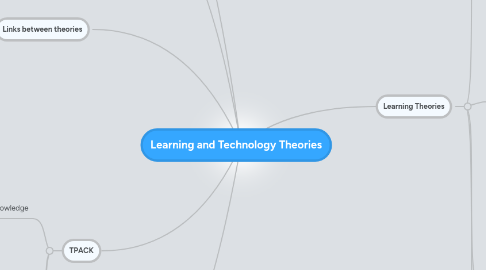
1. Implications for Education
1.1. These theories are forever going to be changing and expanding.
1.2. How teachers teach is going to constantly evolve.
1.3. Teachers are able to combine these theories and create a really good learning environment. They do not have to believe in/use just one learning theory.
1.4. Teachers can help students learning using a combination of different theories. Some students may remember information using acronyms while others may learn while having online discussions about certain topics. Also, some information in general, such as the directions on a compass may be remembered easily with an acronym such as "Never Eat Soggy Wieners".
2. Technology Theories
2.1. SCOT
2.1.1. Social Construction of Technology
2.1.2. POV: People influence the use of certain technology.
2.1.3. Bijker, Pinch
2.2. Media Ecology
2.2.1. POV:Technology influences society
2.2.2. Postman, Mc Luhan
3. Links between theories
3.1. All of the learning theories have an impact on how information is taught in the classroom.
3.2. All of the learning theories have the "answer" to how learning can be accomplished.
3.3. They all have different tools that can be used in order to increase learning. ie: acronyms, positive or negative punishment,
3.4. Some of the theories are focused on behaviour while others are focused on how learning is best accomplished.
3.5. All theories have evolved with time and built on the knowledge that another theory has explored.
4. TPACK
4.1. Technological Knowledge
4.1.1. Pedagogical Knowledge
4.1.1.1. Content Knowledge
4.1.1.2. How much a teacher knows about a certain subject
4.1.1.3. How qualified a teacher is to teach a certain subject.
4.1.1.4. Ex: a Math teacher might be an awesome Math teacher because he/she is so qualified and knows so much material beyond what he/she is teaching in class.
4.1.2. The knowledge a teacher has about how to teach in a way that all students can understand and learn.
4.1.3. Teaching in different ways for different students.
4.2. The ability of a teacher to integrate technology in the classroom to increase the knowledge of a student
4.3. Through games, online resources, SMARTBoards, iPads, individual computers/laptops,,,
5. Philosophy of Technology
5.1. A statement about how a person feels about the use of technology. Ex: whether or not a teacher feels technology should be used in the classroom.
5.2. PLN: Professional Learning Network
5.3. Using technology in the classroom: for example, if a classroom should be using a social networking site, such as twitter to discuss topics discussed in class in greater detail or to have a teacher website to inform students and parents of when certain projects are due, background of a certain teacher,,,
6. g
7. Learning Theories
7.1. Constructivist
7.1.1. Building blocks: building on past experiences or knowledge in order to learn new information
7.1.2. Teaching students assuming they have a foundation in certain subjects. For example, teaching multiplication with the knowledge that all students already know how to add and subtract
7.1.3. It is an individual experience. One learns through experiences and discoveries.
7.1.4. Piaget
7.1.4.1. Came up with the Constructivist Theory
7.1.4.2. Learning is made possible through the environment. In other words, what one experiences through the environment impacts how and what they learn
7.1.4.3. Interested in cognitive developement
7.1.5. Vigotsky
7.1.5.1. One learns through social experiences
7.1.5.2. Knowledge impacts what you will learn in the future
7.1.5.3. Culture impacts what and how one learns
7.1.6. Discussion and Guidance is a key part of this theory. These things impact the methods a teacher will use while teaching. When students experience this new information, they keep the information in their minds for longer. Once teachers understand this, they will teach more effectively.
7.2. Cognitivism
7.2.1. JS Burner
7.2.1.1. Structure, Structure, Structure!!!
7.2.1.2. Knowledge structure, Structural frameworks
7.2.2. Vygotsky
7.2.2.1. Social change=Developement change
7.2.3. Piaget
7.2.3.1. Theory of Cognitive Dev't
7.2.4. Organization of information and how a student learns is important
7.2.5. Ways of thinking: example: making up songs to remember information, memorization, acronyms, review, etc.
7.2.6. Short term, long term, and working memory
7.2.7. Ex: a teacher can give students ways to remember certain information, such as a list of information that they need to know. An acronym.
7.3. Behaviorism
7.3.1. Thorndike
7.3.1.1. Positive Rewards
7.3.1.1.1. Stimulus <--> Response
7.3.2. Skinner
7.3.2.1. Reinforcement
7.3.2.1.1. Dog & Food Experiment
7.3.2.1.2. Positive, Negative and Non-Reinforcement
7.3.3. R. M. Gagne
7.3.3.1. "Learning Hierarchy"
7.3.4. Cause and Effect: Example- If a teacher responds positively to a positive behaviour, the behaviour is likely to occur again. If a teacher responds negatively to a negative behaviour, the behaviour is less likely to occur again.
7.4. Connectivism
7.4.1. Ability to find information one needs, not know it or memorize it
7.4.2. One of the newest learning theories (2006)
7.4.3. Currency is key
7.4.4. Instead of getting one main opinion or point of view in a textbook, a student can read about many different points of view and have a learning experience, making up their mind about a topic.
7.4.5. Twitter, Facebook, Search engines.
7.4.6. Critique: Wrong/misleading information on the internet or on learning networks.
7.4.7. For teachers: a Twitter account for a certain class, encouraging the use of search engines and learning networking tools for finding information
